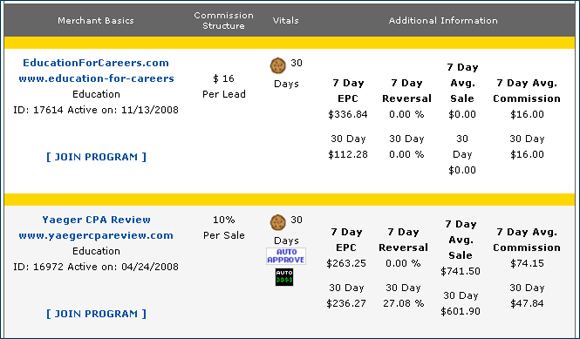I’ve had a merchant approach me with a basic question, but since many other merchants who are also new to affiliate marketing may wonder about the same things, instead of just replying to him via email, I am posting my reply below.
This particular merchant is considering starting his first-ever affiliate program on ShareASale, and is currently crunching numbers to calculate an attractive affiliate commission rate. He wrote:
I’m trying to figure out what commission I should offer to affiliates. (I know from your blog that I need to leave room for special deals, super affiliates, etc.) SAS gave me a demo affiliate account to view merchants in similar categories. Here’s the problem: I can’t figure out how SAS is calculating their statistics…
…and the following example is given:

He is then asking me (a) how to read the data given in the “additional information” column (such as EPC, reversal rate, etc), and (b) how to use it to calculate a competitive affiliate commission for his niche (in this case, it is the “Education” vertical).
Let me answer the first question first:
- The 7 Day and 30 Day stats given above reflect affiliate program statistics for rolling periods of 7 and 30 days respectively
- EPC in this particular example stands for affiliate earnings (average across the program) per 100 clicks sent to the merchant [more on EPC here]
- The Reversal value reflects the reversal rate of affiliate-referred sales/leads (e.g.: if the reversal rate is 10%, then every 10th affiliate transaction (and consequently commission paid) has been reversed)
- Avg. Sale stands for the average affiliate-referred order value over a given period of time
- Avg. Commission shows you the actual average affiliate payout per transaction (e.g.: if it’s $74.15, then this is the average payout affiliates have earned from every sale referred)
To address the second question:
- You really cannot use the above-explained stats in calculating a competitive commission for your field/niche. This data does give you valuable information on what’s happening in your competitors’ affiliate programs; but to evaluate the competitiveness of your commission offer, you want to look in the “commission structure” column, and also check if there are any performance-based bonuses (or tiered commission increases) offered by competing affiliate programs. Also, do not limit your research only to the affiliate network that you’re going to be on. Study competing affiliate programs run on in-house platforms, and other affiliate networks. Many will not give you such data as the “reversal rate” that ShareASale gives, or the conversion rate that is so important for affiliates, but as far as the research into such basics as the commission and cookie life, all affiliate programs display this information to prospective affiliates prior to joining. So, just open affiliate accounts with all the major affiliate networks, and do your research.
- Also, the post you’ve referred to — or How To Calculate Affiliate Commission Rate — contains a few tips on how to structure your affiliate payouts, factoring in any monetary motivators that you want to factor in.
Geno, thanks for such a thorough explanation. I’m in the process of setting up my affiliate program and your explanation here plus the other detailed information throughout your blog has been invaluable. I’ve learned very quickly that when I need information on an element of affiliate marketing, that this is where I turn for best practices. Thanks again!